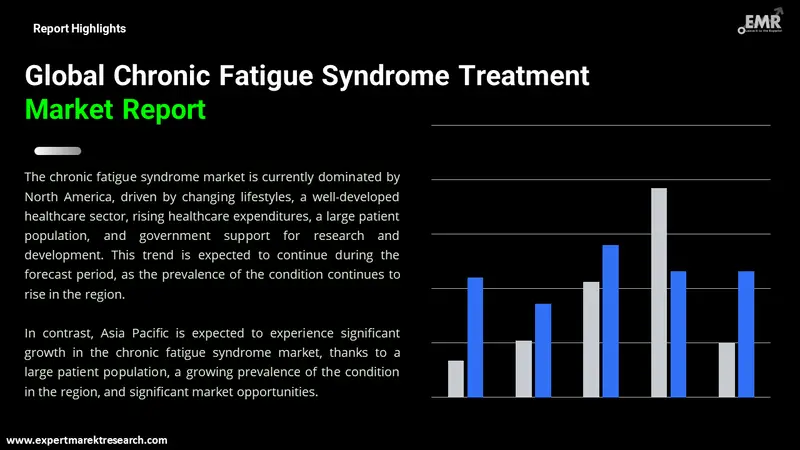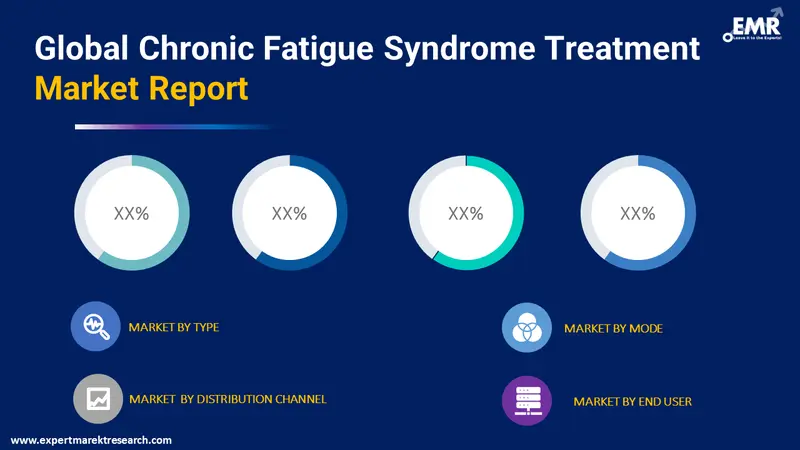
Consumer Insights
Uncover trends and behaviors shaping consumer choices today
Procurement Insights
Optimize your sourcing strategy with key market data
Industry Stats
Stay ahead with the latest trends and market analysis.
The chronic fatigue syndrome treatment market was valued at USD 125.90 Million in 2025 and is expected to grow at a CAGR of 4.80%, reaching USD 201.20 Million by 2035. The market is experiencing growth due to rising awareness of chronic fatigue syndrome and increasing investment in therapeutic research.
Base Year
Historical Period
Forecast Period
The market is driven by the growth in the number of clinical trials and research collaborations aimed at finding effective treatments for chronic fatigue syndrome.
The rising shift towards immunomodulatory therapies and the increasing adoption of non-pharmacological treatment options are major market trends.
The growing emphasis on the discovery and validation of biomarkers to develop diagnostic tools and personalized treatment plans is poised to elevate the market value in the forecast period.
Compound Annual Growth Rate
4.8%
Value in USD Million
2026-2035
*this image is indicative*
Chronic fatigue syndrome (CFS) is a medical condition that causes extreme fatigue or tiredness that does not go away with rest and cannot be explained by an underlying medical condition. Chronic fatigue syndrome is also known as myalgic encephalomyelitis (ME) or systemic exertion intolerance disease (SEID). Because there is no specific test for chronic fatigue syndrome, it is diagnosed based on the symptoms and the exclusion of other conditions that could be causing the symptoms. While there is currently no cure for chronic fatigue syndrome, there are treatments that may help manage the condition.

Read more about this report - REQUEST FREE SAMPLE COPY IN PDF
Recent data reveals that 1% of the adult population in the United States is affected by chronic fatigue syndrome . Women are 2-4 times more likely than men to be diagnosed with the condition. Chronic fatigue syndrome is most common in people in their 40s and 50s. Blacks and Latins are reported to be affected more frequently and severely than other groups.
The chronic fatigue syndrome treatment market is driven by the growing awareness and understanding of the syndrome, which is leading to a higher diagnosis rate and a substantial demand for effective treatment options. It is poised to grow at a CAGR of 4.80%during the forecast period of 2026-2035. This rising demand also fuels the research and development in the market along with attracting pharmaceutical companies to invest in new treatments. The increase in the number of clinical trials and research collaborations aimed at finding evidence-based treatments is anticipated to support the market growth in the forecast period.
Increased Clinical Research to Drive Market Growth
The growing emphasis on clinical research, particularly in areas with limited treatment options such as myalgic encephalomyelitis/chronic fatigue syndrome (ME/CFS), is a significant driver of market growth. For instance, in July 2024 , a six-year follow-up data that analyzed two clinical trials evaluating treatments for myalgic encephalomyelitis/chronic fatigue syndrome (ME/CFS), the RituxME trial and the CycloME trial, revealed that cyclophosphamide is linked with greater and more lasting improvements compared to rituximab or placebo. The study results also indicate that an autoimmune pathomechanism might be associated with chronic fatigue syndrome, which makes immunomodulatory drugs a potential treatment option. The rise in such research studies directed at finding evidence-based treatments are projected to fuel market growth.
Some of the notable trends include a growing focus on immunomodulatory therapies due to emerging evidence of immune system involvement in the disease. There is also increased emphasis on biomarker discovery to support more accurate diagnosis and personalized treatments. Additionally, the integration of cognitive behavioral therapy (CBT) and the rising adoption of alternative and complementary approaches such as yoga, meditation, and nutritional therapy are contributing to evolving treatment strategies and driving market demand.

Read more about this report - REQUEST FREE SAMPLE COPY IN PDF
Chronic Fatigue Syndrome Treatment Market Report and Forecast 2026-2035 offers a detailed analysis of the market based on the following segments:
Market Breakup by Treatment
Market Breakup by Route of Administration
Market Breakup by End User
Market Breakup by Distribution Channel
Market Breakup by Region
Market Segmentation Based on Treatment is Set to Witness Substantial Growth
Common treatment methods for chronic fatigue syndrome include antidepressants, pain relievers, sleep aids, and immunomodulators, among others. The condition cannot be managed with just one treatment since the symptoms are dynamic. Chronic fatigue syndrome causes a symptom of depression in many cases. Low-dose antidepressant therapy or a referral to a mental health provider may be required. If lifestyle changes do not result in a restful night's sleep, sleep aids are often recommended. Pain relievers are also commonly used to manage aches and joint pain caused by chronic fatigue syndrome.
Based on the region, the market includes the United States, EU-4 (Germany, France, Italy, Spain), and the United Kingdom, Japan, and India. The United States dominates the market due to rising healthcare expenditures, a well-developed healthcare sector, a large patient pool, and government support for research and development. The region is likely to witness market growth in the forecast period as well due to the rising prevalence of the condition and the increasing patient awareness. Further, the growth of patient advocacy groups and support networks working towards advancing care for chronic fatigue syndrome patients is poised to aid market expansion in the region.
The key features of the market report comprise epidemiology forecast, patent analysis, clinical trial and pipeline analysis, grant analysis, funding and investment analysis, and strategic initiatives by the leading key players. The major companies in the market are as follows:
Pfizer is a dominant player in the market known for investing heavily in the areas of neuroscience and immunology. The company is actively exploring novel drug candidates for chronic neurological conditions, including chronic fatigue syndrome.
Indian multinational pharmaceutical company Torrent Pharmaceuticals Ltd . boasts a robust pipeline of products aimed at treating neurological and psychiatric disorders. The company leverages strategic acquisitions to expand its market presence.
Cadila Pharmaceuticals Ltd., a leading pharmaceutical company based in India, is engaged in the development of treatments for a range of chronic conditions including therapeutic solutions that could benefit patients with chronic fatigue syndrome.
Mylan Pharmaceuticals Inc., headquartered in West Virginia, United States, is a generic and specialty pharmaceutical company. Its antidepressant drugs are often used to manage depressive symptoms in chronic fatigue syndrome patients.
*Please note that this is only a partial list; the complete list of key players is available in the full report. Additionally, the list of key players can be customized to better suit your needs.*
Other key players in the market include Mallinckrodt Pharmaceuticals, Eli Lilly and Company, Novartis AG, Sun Pharmaceutical Industries Ltd., AIM ImmunoTech Inc., and H Lundbeck A/S.




*While we strive to always give you current and accurate information, the numbers depicted on the website are indicative and may differ from the actual numbers in the main report. At Expert Market Research, we aim to bring you the latest insights and trends in the market. Using our analyses and forecasts, stakeholders can understand the market dynamics, navigate challenges, and capitalize on opportunities to make data-driven strategic decisions.*
Get in touch with us for a customized solution tailored to your unique requirements and save upto 35%!
Explore our key highlights of the report and gain a concise overview of key findings, trends, and actionable insights that will empower your strategic decisions.
| REPORT FEATURES | DETAILS |
| Base Year | 2025 |
| Historical Period | 2019-2025 |
| Forecast Period | 2026-2035 |
| Scope of the Report |
Historical and Forecast Trends, Industry Drivers and Constraints, Historical and Forecast Market Analysis by Segment:
|
| Breakup by Treatment |
|
| Breakup by Route of Administration |
|
| Breakup by End User |
|
| Breakup by Distribution Channel |
|
| Breakup by Region |
|
| Market Dynamics |
|
| Supplier Landscape |
|
| Companies Covered |
|
Datasheet
One User
USD 3,299
USD 2,969
tax inclusive*
Single User License
One User
USD 5,499
USD 4,949
tax inclusive*
Five User License
Five User
USD 6,999
USD 5,949
tax inclusive*
Corporate License
Unlimited Users
USD 8,199
USD 6,969
tax inclusive*
*Please note that the prices mentioned below are starting prices for each bundle type. Kindly contact our team for further details.*
Flash Bundle
Small Business Bundle
Growth Bundle
Enterprise Bundle
*Please note that the prices mentioned below are starting prices for each bundle type. Kindly contact our team for further details.*
Flash Bundle
Number of Reports: 3
20%
tax inclusive*
Small Business Bundle
Number of Reports: 5
25%
tax inclusive*
Growth Bundle
Number of Reports: 8
30%
tax inclusive*
Enterprise Bundle
Number of Reports: 10
35%
tax inclusive*
How To Order

Select License Type
Choose the right license for your needs and access rights.

Click on ‘Buy Now’
Add the report to your cart with one click and proceed to register.

Select Mode of Payment
Choose a payment option for a secure checkout. You will be redirected accordingly.
Gain insights to stay ahead and seize opportunities.

Get insights & trends for a competitive edge.

Track prices with detailed trend reports.

Analyse trade data for supply chain insights.

Leverage cost reports for smart savings

Enhance supply chain with partnerships.

Connect For More Information
Our expert team of analysts will offer full support and resolve any queries regarding the report, before and after the purchase.
Our expert team of analysts will offer full support and resolve any queries regarding the report, before and after the purchase.
We employ meticulous research methods, blending advanced analytics and expert insights to deliver accurate, actionable industry intelligence, staying ahead of competitors.
Our skilled analysts offer unparalleled competitive advantage with detailed insights on current and emerging markets, ensuring your strategic edge.
We offer an in-depth yet simplified presentation of industry insights and analysis to meet your specific requirements effectively.
Share